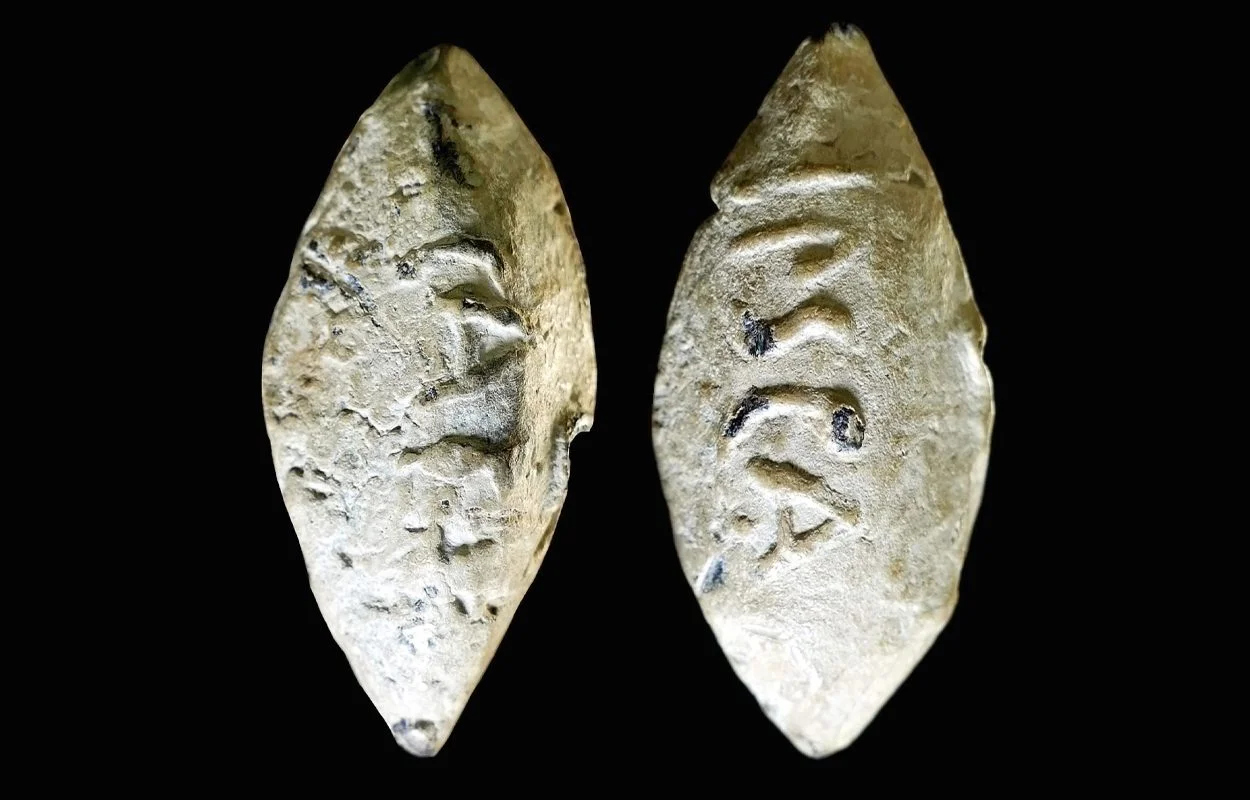
In the picturesque countryside of Montilla, Andalusia, a discovery has stirred the imagination of historians and archaeologists alike. Around 2,000 years ago, this now serene landscape in Spain was the site of a brutal battle between Caesar and the Optimates during the Second Hispanian campaign of Caesar’s Civil War.
It is there that researchers discovered a lead sling bullet, inscribed with the abbreviated name of Julius Caesar — CAES — marking a significant find in the annals of Roman military history. The bullet also bears a second inscription: IPSCA, a reference to a supposed Roman city on the edge of present-day Baena.
Caesar’s bullet
The sling, a simple yet effective hand-powered weapon, has roots stretching back to the Upper Palaeolithic period. This ancient armament, consisting of a pouch between two cords, was used for hurling projectiles with surprising accuracy and force. It found its place alongside other emerging warfare technologies like the spear-thrower and the bow and arrow.
The sling gained prominence in Ancient Greece and continued its legacy into the Roman period. Roman armies, valuing its utility and ease of use, incorporated the slingers, known as Funditores, into their ranks. The sling bullet from Montilla is linked to a tumultuous period in Roman history. The Second Hispanian Campaign of Caesar’s Civil War, a pivotal chapter in ancient Roman history, took place around 45-44 BCE.
This campaign was part of the broader conflict known as Caesar’s Civil War, which erupted due to the political and military rivalry between Julius Caesar and the Roman Senate, led by Pompey the Great. Following his decisive victory at Pharsalus in Greece, Caesar turned his attention to Hispania (modern-day Spain and Portugal), where Pompey’s supporters, known as the Optimates, had regrouped and continued their resistance.
The campaign culminated in the Battle of Munda, where Caesar achieved a hard-fought victory, effectively ending the resistance against him and paving the way for his undisputed control over the Roman Republic — which transitioned into the Roman Empire upon Caesar’s assassination.
The bullet in question, discovered at Montilla (which likely corresponds to the location of the ancient town of Munda), adds new depth to this ancient story. Measuring 1.8 inches by 0.8 inches and weighing 2.5 ounces, the lead bullet is etched with the inscriptions “CAES” and “IPSCA” on either side, archaeologists reported in the journal Zephyrus. It was manufactured using a mold into which artisans poured molten lead.
The significance of the “IPSCA” inscription is particularly intriguing. The authors of the new study speculate it refers to the location of an ancient, yet unrecorded town. This discovery aligns with Latin historical accounts, such as Bellum Hispaniense, chronicling Caesar’s military campaigns. The inscription implies Ipsca’s support for Caesar, suggesting the town had a key role in supplying ammunition and possibly even slinger troops for Caesar’s army.
Romans etched messages on their projectiles as political propaganda as a form of morale boost for the soldiers flinging the shots. It’s a remarkably time-honored tradition. For instance, it was routine for soldiers on both sides during WWII to write “lovely” messages on bombs and artillery shells like “Happy Easter, Adolph”. More recently, in the ongoing Ukraine-Russia war, both Russian and Ukrainian soldiers often write short messages on artillery shells, such as “Russians never give up” or “Glory to Ukraine”.

Obviously, these messages are never read by the enemy because they are obliterated along with the exploding ordinance — they are instead photographed and distributed across social media before the shells are fired. Inscriptions etched on ancient bullets served the same purpose of encouraging troops during the Roman Civil Wars.
Intriguingly, only one other bullet with Caesar’s name on it has ever been found. It was also found in Spain, in the province of Jaén, bearing the inscription “CAE / ACIPE” — the Latin equivalent of “Suck it, Caesar,” reports Live Science. This shows how widespread psychological warfare was even during Antiquity. In fact, the Romans used their bullets in surprising ways to instill terror and fright upon the enemy.
The terror of whistling bullets

In 2016, in the rolling hills of southwestern Scotland, archaeologists unearthed a remarkable glimpse into ancient Roman military strategy. At Burnswark Hill, the remnants of a second-century A.D. battle tell a story of psychological warfare and tactical ingenuity. It is there that researchers discovered small, cast lead sling bullets, each weighing about 30 grams.
Uniquely, these bullets contain a 5-millimeter hole, a design believed to produce a terrifying buzzing or whistling noise as they soar through the air. As these bullets whistled throughout the battlefield, enemy forces would have certainly been intimidated and distracted.
Notably smaller than standard sling bullets, these whistling projectiles were likely used en masse. Soldiers could launch several bullets simultaneously, creating a scattershot effect. This tactic suggests a focus on close-quarter skirmishing, bringing Roman soldiers within striking distance of their adversaries.

The Roman auxilia, specialized units accompanying the legions, were sling specialists. Among the most skilled were slingers from the Balearic Islands, who had honed this art from a young age. In expert hands, a sling bullet could reach staggering speeds of up to 100 mph, making them deadly weapons.
Sling bullets and stones are common artifacts at Roman military sites across Europe. Interestingly, about 20% of the sling bullets at Burnswark Hill feature distinctive drilled holes. The effort invested in modifying these bullets shows just how tactically important they must have been.
Although the Romans perfected whistling bullets, they were not the ones to invent them. Similar whistling bullets have been found at Greek battle sites dating back to the second and third centuries B.C. Initially thought to be poison reservoirs, these Greek bullets are now recognized as part of ancient sound-based warfare.
The Roman attack on Burnswark Hill was likely part of a larger campaign to expand Roman control into Scotland. Despite the technological and tactical superiority of the Roman forces, the resilient Scottish tribes held their ground, ultimately leading to the Roman retreat to Hadrian’s Wall.
The Caesar-inscribed projectiles and the whistling bullets both paint an intriguing picture of psy games during an era that many view as unsophisticated and plain. In reality, the mind games are quite the same as today. It’s just the tools that are different.






